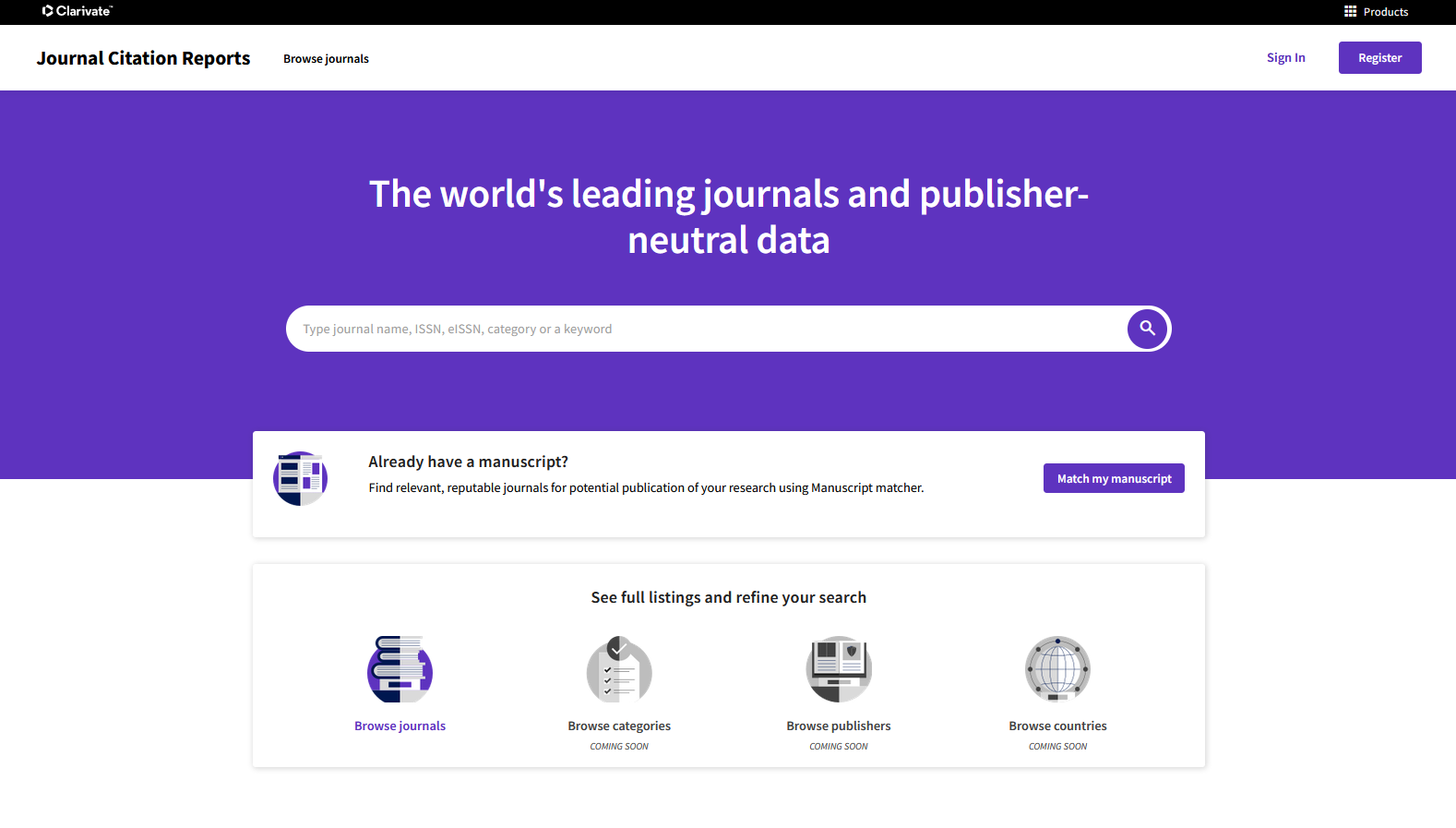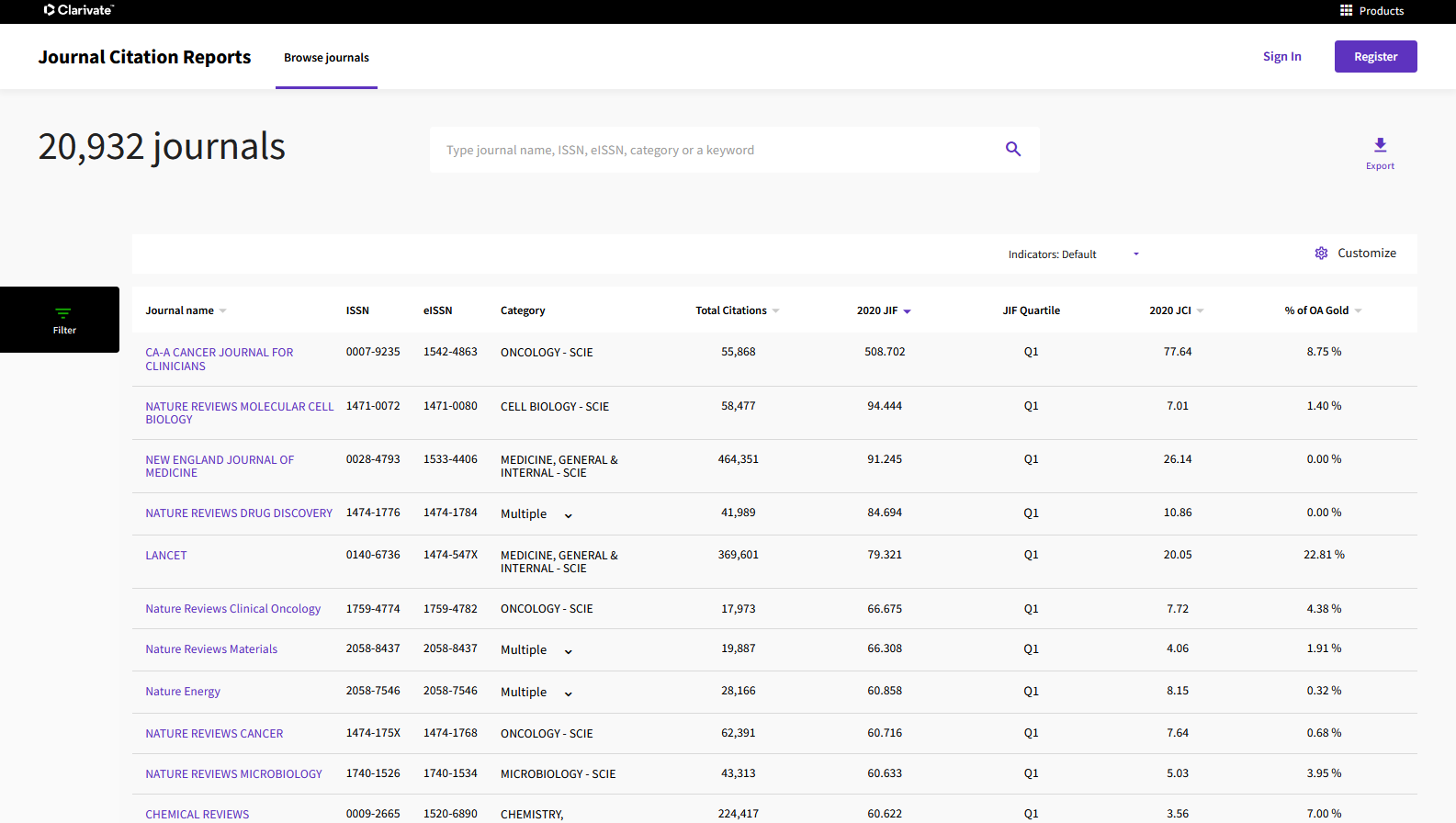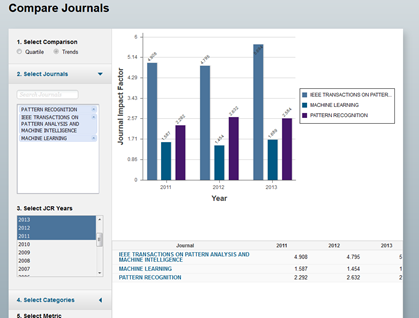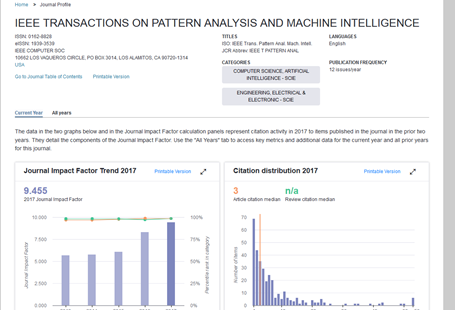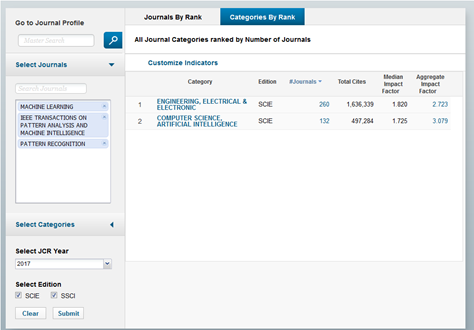Journal Impact Factor
Journal Impact Factor
What is the impact factor?
The impact factor is a metric (numerical value) to evaluate how much impact a journal (scientific journal) has. It provides a method for comparing journals in the same field.
This metric is calculated each year based on the citation status of articles published in the last two years in a journal.
The calculation is based on the data of Web of Science, a database of Clarivate Analytics.
How to calculate
The formula for calculating the impact factor of a given journal for a given year is as follows:
(Number of citations received in that year for articles published in that journal in the two preceding years) / (Total number of articles published in that journal during the two preceding years)
For example, the impact factor of a given journal for 2018 can be calculated as follows:
Example:
Assume that a certain journal carried 305 articles in 2016 and 315 in 2017.
For these 620 (= 305 + 315) articles, the number of citations in 2018 amounted to 1,519.
The impact factor of that journal for 2018 can be calculated as follows:
(Number of citations in 2018 for articles published in 2016 + that for articles published in 2017)
/ (Total number of articles published in 2016 and 2017)
= 1519/620 = 2.45 (number of citations per article)
Other metrics
Several metrics other than the impact factor are available in Journal Citation Reports.
- 5-Year Impact Factor
- Immediacy Index (See also "Immediacy Index" in "Help" of InCites)
- Eigenfactor Score (Reference: About the Eigenfactor® Project)
This is a metric that is weighted so that its value becomes higher for journals that receive larger numbers of citations than those that receive smaller numbers. The idea is to make up for the shortcoming that the impact factor tends to be higher for journals that carry fewer articles.
This is a variation of the impact factor that is calculated based on citation data for the preceding five years, instead of the preceding two years.
It is suitable for journals in fields with a long period from publication to citation.
This is a metric that is calculated as the average number of citations the articles in a journal received in a given year.
It is useful for comparing journals in cutting-edge fields.
Caveat
(See also "The Clarivate Analytics Impact Factor")
☆Unsuitable for comparison between journals of different fields
Determining the impact factor involves various factors such as the researcher population and citation trends in each field, and citations, if any, from other fields. For this reason, comparison in terms of the impact factor is meaningless between journals in fields that significantly differ in citation practices (in terms of the average number of citations, the relationship between the time after publication and the number of citations received, among other factors). In its formal Q&A, Clarivate Analytics recommends such means as comparison in terms of the number of citations made to, and the number of citations received from, highly ranked journals in the same field.
☆Not designed to evaluate articles or researchers
Remember that the impact factor is given to journals. It does not necessarily provide an accurate representation of the citation status of individual articles. The risk of repurposing the impact factor of a given journal to evaluate articles in that journal is detailed in “Citation Statistics,” a report by the joint committee of the International Mathematical Union (IMU), the International Council of Industrial and Applied Mathematics (ICIAM), and the Institute of Mathematical Statistics (IMS). This report is translated into Japanese by the Mathematical Society of Japan. The research performance analysis tool “InCites” is useful for evaluating individual articles and researchers.
☆Caution needed for the impact factor of small-scale academic journals
By the very nature of its calculation method, the impact factor value may vary greatly by chance for small-scale journals. As far as small-scale academic journals are concerned, check the impact factor not only for a given year but also for several years preceding it.
☆Unable to represent other aspects than the number of citations
Keep in mind that the impact factor is a metric based on the number of citations. It does not represent such aspects as the trends in articles published in a given journal, the detailed field of that journal, and what kind of journals have made many citations.
Check impact factors with Journal Citation Reports
How to check
Impact factors are listed in the database "Journal Citation Reports (JCR)". Because HU is subscribed to Journal Citation Reports, access to it can be made from within the campus. From outside the campus, use the remote access service.
Journal Citation Reports provides various ways to check and compare impact factors. (See also the Journal Citation Reports: Learn the Basics)
List of journals
From the website, select “Browse Journal” to show a list of journals in terms of title, impact factor, and other items. Click the “Filter” button on the left to sort journals by impact factor, the total number of citations received, etc. and to specify journals by title and category.
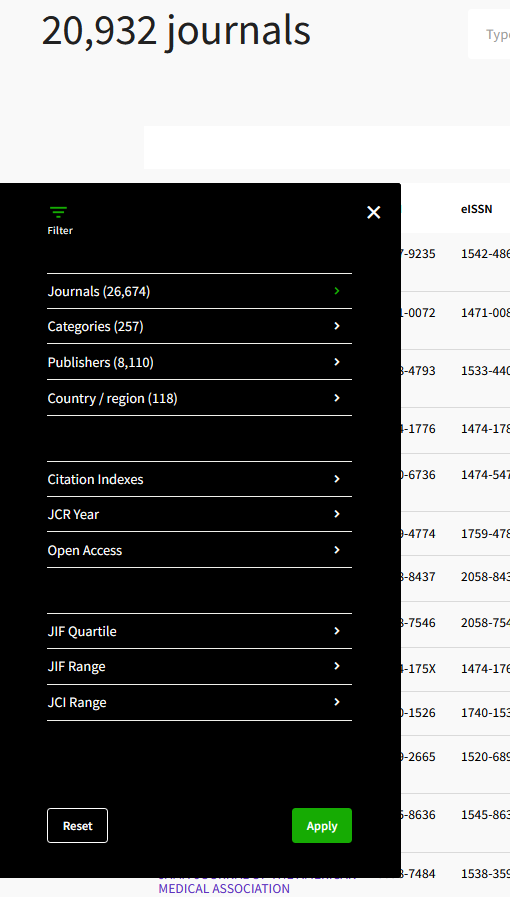
The list can be filtered by category, publishers, open access status, and others.
Described below are the features that were available in Journal Citation Reports(Classic), a former version of the interface.
These include features that are noted as “COMING SOON” in the new interface as of August 11, 2021.
(The former version of the interface will remain accessible until the end of 2021, according to Clarivate’s press release titled “Clarivate Releases Journal Citation Reports, Naming the World’s Leading Journals.”)
Compare journals
Select “Browse by Journal” and then select “Compare Journals” on the menu on the left to compare journals by impact factor and other items.
Display the detailed information of journals (Journal Profile)
Click the journal title of your choice on the list of “Browse by Journal” to see the detailed information of that journal as shown below:
- Impact factor trends for the past five years
- Distribution of citations of articles published in that journal for each year
- A list of journals by title that cite articles published in that journal
- Top 10 institutions to which the authors who submit their papers to that journal belong
- Titles of both journals that cite articles published in that journal and those from which such articles make citations
List of fields (Browse by Category)
Select “Browse by Category” from the website to check the statistics of impact factors by category (field), such as the average and mean values of the impact factor for each category. Also, click the number of your choice in the “#Journals” column to show a list of journals in that category. You can specify the categories concerning that journal based on its title. (Search for journal titles from “Select Journals” in the left column and specify the related categories from the journal title).
Additional information
User Guide for Clarivate Analytics Products
https://clarivate.jp/training/web-of-science/
The section on the impact factor – journal metric, Journal Citation Reports in this page provides operational descriptions.
FAQ on the impact factor
https://clarivate.jp/products/journal-citation-reports/impact-factor/
This page provides an overview of the impact factor as well as frequently asked questions on how to use it.
A guidance movie in the learning portal of Clarivate Analytics
https://clarivate.com/webofsciencegroup/support/support-jcr/
【Contact】 University Library Academic Information Support Division (jsa [at] lib.hokudai.ac.jp)



